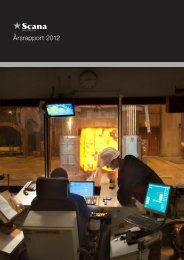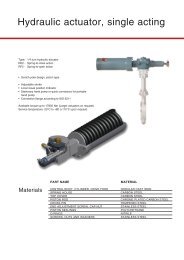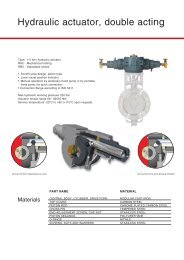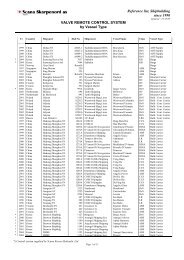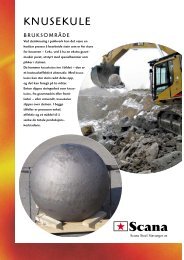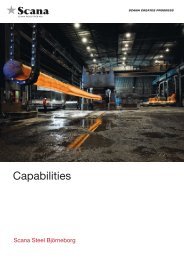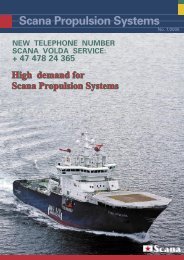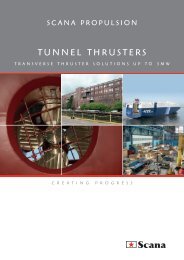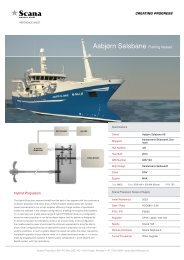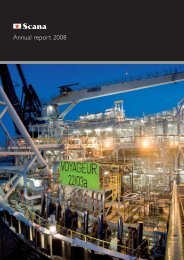Annual Report 2010 - Scana Industrier ASA
Annual Report 2010 - Scana Industrier ASA
Annual Report 2010 - Scana Industrier ASA
You also want an ePaper? Increase the reach of your titles
YUMPU automatically turns print PDFs into web optimized ePapers that Google loves.
52<strong>Annual</strong> <strong>Report</strong> <strong>2010</strong> <strong>Scana</strong> <strong>Industrier</strong> <strong>ASA</strong>amendment will allow entities to recognise a prepayment of pensioncontributions as an asset rather than as an expense. The amendmentis effective for annual periods beginning on or after 1 January 2011.The Group expects to implement the amendment as of 1 January2011.IFRIC 19 Extinguishing Financial Liabilities with Equity InstrumentsThe interpretation clarifies the accounting treatment of financialliabilities that, as a result of a renegotiation of the terms of thefinancial liability, are fully, or partially, extinguished with equityinstruments. The interpretation is effective for annual periodsbeginning on or after 1 July <strong>2010</strong>. The Group expects to implementIFRIC 19 as of 1 January 2011.The group does not expect the implementation of the aforementionedproposals to have any effect on the consolidated accounts on theimplementation date, but will undertake further analyses of thevarious proposals before implementation.Foreign currency translationTransactions in foreign currencies are accounted for at the exchangerate on the date of the transaction. Monetary assets and liabilities inforeign currencies are translated at the exchange rate on the balancesheet date. Any exchange differences are entered in the profit andloss account under financial items.Balance sheet items relating to foreign subsidiaries are translatedinto NOK using the exchange rate as at 31 December. All items in theprofit and loss account are translated into NOK at weighted averageexchange rates. Consolidation gives rise to translation differences,which are taken directly to total comprehensive income in the groupbalance sheet. Translation differences relating to debt in foreigncurrency that for accounting purposes are considered to be hedgingof investments in foreign subsidiaries and the currency effects relatedto cash items that represent a proportion of the net investment inforeign subsidiaries, are also charged against total comprehensiveincome until the subsidiary is divested.Significant accounting judgements and estimatesManagement has used estimates and assumptions that affectthe recognition and measurement of assets, liabilities, revenues,expenses and information on contingent liabilities. This particularlyapplies to the entering of revenues from long-term manufacturingcontracts, depreciation and write-down valuations of fixed assets,income tax, evaluations of losses on accounts receivable, evaluationsof dead stock linked to inventories, recognition of development costs,and valuations of pension obligations. Future events may lead tothese estimates being changed. Future events may lead to changesin these estimates. Estimates and the underlying assumptionsare evaluated on an ongoing basis. Amendments to accountingestimates are entered in the accounts in the period in which thechanges occur. See also note 2.SIGNIFICANT ACCOUNTING POLICIESRevenuesRevenue is recognised when it is probable that transactions willgenerate future economic benefits that will be transferred to thecompany and the amount can be reliably estimated. Sales revenuesare presented net of VAT and discounts.Revenues from the sale of goods are recognised in the profit andloss account once delivery has taken place, i.e. when the risks andpotential gains associated with the goods are transferred to the buyerand the company has established a claim against the customer.Rental income is recognised on a linear basis over the rental period.Revenues relating to long-term manufacturing contracts (projects)are recognised in the profit and loss account in line with the project’sprogress and when the project’s results can be reliably estimated.The degree of completion is calculated using the method that is mostappropriate for the individual contract, which is normally the accruedcosts as a percentage of estimated total costs. When the project’sresults cannot be reliably estimated, only revenues equal to theaccrued project costs will be recognised as revenue. Any loss on acontract will be recognised in full in the profit and loss account for theperiod when it has been determined that the project will incur a loss.Accrued income, not received, is included in the balance sheet underother current receivables. Advances on long-term contracts arepresented in the balance sheet under other current liabilities.Royalties will be recognised in the profit and loss account in relationto the terms and conditions of the various royalty agreements.Dividends are recognised in the profit and loss account for theperiod when the shareholders’ rights to receive dividends have beendetermined.Interest income is recognised as interest accrues.Taxes in the profit and loss account are the sum of tax payable andchanges in deferred tax.Intangible assetsIntangible assets with limited lives are amortised over the useful lifeand assessed for write-down whenever there is an indication thatthe intangible asset may be impaired. The amortisation period andthe amortisation method for an intangible asset with a limited usefullife are reviewed at the end of each financial year as a minimum.Changes in the expected useful life or the expected pattern ofconsumption of the intangible assets are accounted for by changingthe amortisation period or method, as appropriate, and treated aschanges in accounting estimates.Internally-generated intangible assets, excluding capitaliseddevelopment costs, are not capitalised and the expenditure ischarged against profits in the accounting period in which theexpenditure is incurred. The useful life of intangible assets isassessed to be either limited or undefined.GoodwillGoodwill that arises from an acquisition of business is valued at cost.This constitutes the part of the total acquisition cost that exceedsthe net fair value of identifiable assets, debt and contingent liabilities.Following initial recognition, goodwill is valued at cost price less anyaccumulated write-downs. Goodwill is not amortised, but is assessedannually for any write-downs, or more frequently if events or changesin circumstances indicate that the book value may be impaired.Research and development costsResearch and development costs are expensed as incurred.An intangible asset that results from development expenditurein an individual project is capitalised when the following can bedemonstrated: the technical feasibility of completing the developmentof the intangible asset so that it will be available for use or sale, itsperformance potential and its potential to use or sell the asset, howthe asset will generate future economic benefits, that it has theresources needed to complete the development of assets and toreliably measure the development costs. Capitalised developmentcosts are entered in the balance sheet at acquisition cost minusaccumulated depreciation and write-downs. Capitalised developmentcosts are depreciated on a linear basis over the asset’s estimateduseful life. Any expenditure capitalised is amortised over the period ofexpected future sales from the related project.The book value of development costs is reviewed for impairmentannually or more frequently when an indication of impairment arisesduring the reporting year.Gains or losses arising from the disposal of an intangible asset arecalculated as the difference between the net disposal proceeds andthe book value, and are recognised in the profit and loss account.Tangible fixed assetsTangible fixed assets are measured by acquisition cost, minusaccumulated depreciation and write-downs. When assets are soldor transferred, the book value is deducted and any loss or gain isentered in the profit and loss account.



